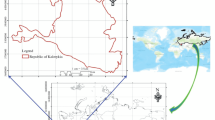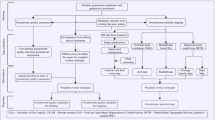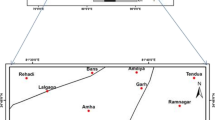Abstract
Groundwater is a very important natural capital for the consistent and economic provision of potable water supply for rural and urban environs. The present scenario of climate change has posed a challenge to the fundamental well-being of all countries, and the situation is even worse in countries or regions which are already suffering from water scarcity. Due to the decreasing trend in rainfall in certain regions and increasing water demands, the surface water sources are depleting and therefore, there is a need to locate alternate sources of water. The development of a reasonable model for groundwater potential can be a better solution. This project aims to generate a groundwater potential zonation map using the integrated use of remote sensing and geographic information system (GIS) for the selected study area. Different thematic maps of information, such as geomorphology, geology, soil type, land slope and land use/land cover, drainage density, lineament density, hydrogeomorphology were integrated with weighted overlay in GIS to generate groundwater potential zonation maps of the area. Based on the groundwater potential index values, the study area is classified as ‘high’, ‘moderate’, or ‘low’. Then the pertinent sites for artificial recharge structures have to be identified by the overlay analysis of the drainage layer and geomorphology of the area through GIS technologies. These structures will be capable of fulfilling the demand for groundwater for future generations.
Access provided by Autonomous University of Puebla. Download conference paper PDF
Similar content being viewed by others
Keywords
1 Introduction
Groundwater is one of the most important natural resources of the earth which is a very essential source for drinking, irrigation, and industrialization purposes. In the absence of good quality sub-surface water and the growing need for water for domestic, agricultural, and industrial uses, groundwater is an attractive source for good quality and replenishment. In the present scenario of urbanisation, industrialisation and population increase, the rate of consumption of groundwater is increasing continuously. So it is important to identify groundwater potential zones and also monitor and conserve these sources. Efficient management of groundwater in these areas is also very important. The occurrence and movement of groundwater in an area is influenced by different parameters such as geology, soil, geomorphology, lineament density, slope, drainage density, land use/land cover, and the interrelationship between these parameters [1]. Artificial recharge systems are engineered systems which impound surface water to infiltrate through soil layers and percolate into the aquifers to augment groundwater resources. In the unsaturated areas, where these cannot be implemented, shafts and trenches can be directly injected through wells to the aquifers. Groundwater potential zones are the zones that mark the availability of groundwater. Identification of groundwater potential zones can benefit in proper development and utilization of both surface water and groundwater resources by eliminating water scarcity. This can enhance agricultural practices and their income. Uneven distribution of groundwater and misuse of water resources in a year often increases the chances of flooding during monsoon. Also significant decrease in water during non-monsoon periods. Appropriate and efficient techniques should be used to find potential sites for drilling of wells and for providing artificial recharge structures. This is to ensure the sustainability of well yields and to overcome the crisis of water table depletion. For efficient and successful studies of groundwater, GIS provides spatial data integration and natural resource management tools [2].
Groundwater quality is one of the major environmental aspects which is to be studied and supervised depending upon its spatial distribution [2]. Due to the lack of effective management, a reduction in quantity and also quality of groundwater can be a problem. The aim of this study is to evaluate groundwater quality in the study area as a case study and the application of spatial distribution by using Geographic Information System (GIS) and geostatistical algorithms. The groundwater quality parameters such as pH, total dissolved solids, total hardness, alkalinity, chloride, nitrate, sulfate, calcium, magnesium, and fluoride, were collected for this. Using the geostatistical (Kriging) method, maps of each parameter were created [3]. This was used to create the groundwater quality index (GWQI) map using the index method. In general, this integrated method is a sufficient assessment tool for environmental spatially distributed parameters.
2 Study Area
Muvattupuzha is located in the east of Kochi in Ernakulam district. Muvattupuzha is the originating point of Muvattupuzhayar. This place is famous for the meeting point of three rivers together namely, Thodupuzhayar, Muvattupuzhayar, and Kaliyar, hence the name Muvattupuzha. The town shares the border with Kottayam district on the south and Idukki on the east. Muvattupuzha Block has an area of 206.07 km2.
3 Objectives and Scope
The objectives of this project are:
-
To generate a groundwater potential zonation map of the selected study area (Muvattupuzha block).
-
Groundwater potential map validation.
-
To propose a suitable artificial recharge method for the areas identified with poor groundwater potential.
The scope of this project includes:
-
Increasing the sustainability of wells.
-
Arresting the declining groundwater level trends.
-
Reducing the reliance on government water supply.
4 Methodology [1, 3,4,5,6]
See Fig. 1.
4.1 Results and Discussions
Slope Map
The slope is the rate of change of elevation and it is considered as the governing factor of superficial water flow, since slope determines the gravity effect on it. The slope is directly proportional to run-off. Groundwater recharge will be less on steep slopes. It is slow in gently undulating plains. Therefore, enough time is available for infiltration. Slope maps were derived from Aster DEM data, which were downloaded from the Earth data, NASA, with 30 m resolution. The study area was masked out from DEM and the slope was derived using the spatial analyst tool in ArcGIS 10.3. From the map generated, most of the region lies under 0–0.42°. So it’s clear that the altitude is much lesser and thus it contains vast flatlands and paddy fields spread around the region. Only a small amount of the region comes under the slopes greater than 15° so that the areas surrounding the Muvattupuzha block are less hilly and highly fertile (Fig. 2).
Land use/land cover map
Land use refers to man’s activities in the land, numerous uses which are carried out on land, etc. Land cover denotes the natural vegetation, water bodies, rocks, etc. that resulted due to land transformation. Thematic map of land use/land cover was collected from Kerala State Remote Sensing and Environmental Centre (KSREC), Trivandrum. From the map, it is evident that almost all of the region is used for agriculture plantation due to the extremely fertile soil encompassing the region. And only less than 20% of the region is used for built-up spares. less than 10% occupied by deciduous forest. Less than 5% used for industrial purposes (Fig. 3).
Geomorphology map
Geomorphological maps portray important geomorphic units, landforms, and underlying geology and aid understanding of the processes, materials/lithology, structures, and geologic controls relating to groundwater occurrence, likewise on groundwater potentials. It is thought about as surface indicators for the identification of subsurface water conditions. Thematic map of geomorphology was obtained from KSREC, Trivandrum. Geomorphology of the region is such that, More than 60% is a plateau region and the rest is the piedmont zone and pediplain region. Less than 5% are residual hills (Fig. 4).
Drainage density map
Drainage density is an inverse function of permeability. The line density tool of the spatial analyst is used to get a density map from the drainage map. Drainage density map was obtained by using the Line Density tool of ArcGIS 10.3. The Line Density tool calculates the density of linear features in the neighborhood of each output raster cell (Fig. 5).
Soil map
Soil characteristics have a substantial role in the infiltration of water. The rate of infiltration largely depends on the grain size of the soil. Thematic map of soil was obtained from KSREC, Trivandrum. Most of the region has a gravel soil formation. Less than 10% is occupied by clayey soil near the North-Eastern region. Most of the region has a fertile soil formation (Fig. 6).
Lineament density map
Lineaments represent zones of faulting and fracturing resulting in increased permeability. They are hydro-geologically vital since they act as pathways for groundwater movement. The lineament density of an area can directly reveal the groundwater potential since the presence of lineaments typically denotes a permeable zone. Areas with high lineament density are good for groundwater potential zones. Lineament map was collected from KSREC. Lineament density was then calculated by spatial density analysis in ArcGIS (Fig. 7).
5 Derivation of Normalised Weights of Thematic Layers by AHP Method
Analytic Hierarchy Process (AHP) is adopted here for the derivation of normalized weights of thematic layers. The AHP method is preferred for decision-making of a problem consisting of several parameters that can affect the result. The stronger the influence of one factor over other factors, the higher its relative importance. Which gives a larger weight (Tables 1, 2 and 3) [5, 2, 7].
9 Groundwater Quality Index
Water Quality Index is one of the most effective tools that can compare water quality parameters with the respective regulatory standards (WHO) and provide a single number that can express overall water quality at a certain location based on several water quality parameters. WQI helps in summarising the water quality into simple terms like good, bad, excellent etc. which are easily understandable by the public. By combining multiple parameters into a single index, a more comprehensive picture of the pollution state is provided. When mapping the index, the areas of high and low water quality can be easily specified. The water quality index is calculated in three steps. First, a weight (wi) was assigned to each of the ten parameters according to its relative importance in the overall quality of water. The weight 5, which is the maximum weight assigned to nitrate, since it is the most affecting component on public human health. A weight of 2 was assigned to magnesium due to its low effect on human health. In the second step, the relative weight (Wi) is computed by:
- Wi:
-
Relative weight;
- wi:
-
Weight of each parameter;
- n:
-
No. of parameters;
In the 3rd step, a quality rating scale (qi), for each parameter was assigned by dividing its concentration in each water sample by its respective standard (WHO standard). And to express it in percentage, the result was multiplied by 100.
- qi:
-
Quality rating scale;
- Ci:
-
Concentration of each pollutant in water sample in mg/L;
- Si:
-
WHO standard concentration;
For computing the WQI, the Si was determined for each parameter. The subindex of ith quality parameter can be determined by:
The computed WQI values are classified into five types as shown in Table 6.
10 Results and Conclusion
10.1 Groundwater Potential Zonation Map
From the different maps studied above we can successfully conclude that GIS and remote sensing can provide a suitable platform for proper analysis of large volumes of data and decision making for the studies of groundwater. This approach has been successfully used and illustrated for the estimation of groundwater potentiality of the Muvattupuzha block, Kerala, India. The use of the weighted overlay method was found to be very convenient in the mapping of groundwater potential zones of the study area (Fig. 33).
10.2 Groundwater Quality Index
Water quality classification based upon WQI value obtained from water quality data (Tables 7 and 8).
From the table it is clear that water drawn from the wells E95, BW112 and the surrounding areas, that are Perumbavoor and Vazhapilly respectively, are unsuitable for drinking purposes. The water quality Index is greater than 300, which shows that the water cannot be used for drinking purposes. The water quality index of the well GW-22 is in between 200–300, hence the water is of poor quality (Figs. 34 and 35).
11 Artificial Recharge Methods
Site characteristics of the study region:
-
The average annual rainfall of of the region varies from minimum of 2779 mm to maximum of 4526 mm.
-
The pH of groundwater lies between 6.5 and 8.5.
-
The region consist of irrigable land.
-
Drainage density varies from 0 to 6.87 km/km2.
The artificial recharge methods which are proposed for the study area based on the site suitability are check dams, contour bunding, rooftop rainwater harvesting and gully plugging. The above methods were selected considering the suitability of the area for recharge in terms of climate, topography, soil, land use characteristics, hydrogeologic set-up, available technical skills, manpower, and management capabilities, and the capacity and willingness of the user community to bear the costs.
Check dams can be constructed across small streams having gentle slopes that are feasible both in hard rock as well as alluvial formation. The site selected for check dam should have sufficient thickness of permeable bed or weathered formation to facilitate recharge of stored water within a short span of time. The water stored in these structures is mostly confined to stream courses and the height is normally less than 2 m.
Contour bunds involve a watershed management practice so as to build up soil moisture storages. This technique is generally adopted in areas receiving low rainfall.
Gully plugs are the smallest run-off conservation structures built across small gullies and streams rushing down the hill slopes carrying drainage of tiny catchments during the rainy season. Usually, the barrier is constructed by using local stones, earth and weathered rock, brushwood, and other such local materials.
In Urban areas, the roof top rainwater can be conserved and used for recharge of ground water. This approach requires connecting the outlet pipe from the rooftop to divert the water to either existing wells/tubewells/borewell or specially designed wells. The urban housing complexes or institutional buildings have a large roof area and can be utilising for harvesting roof top rainwater to recharge aquifers in urban areas.
These are the suggestions for artificial recharge methods suitable for the study area on the basis of its characteristics.
The GIS and remote sensing techniques have helped in:
-
Minimising use of cost, time and labour.
-
Integration of eight thematic maps such as drainage density, rainfall, LULC, slope, geology, geomorphology, lineament density, and soil which gives information to local authorities and planners about the areas suitable for groundwater exploration.
-
Generation of groundwater potential map of the area.
-
To extract useful information from satellite images.
Conclusion:
-
Three groundwater prospect zones were identified and classified as low, moderate, and high potential zones.
-
Low potential zones cover 0.28 km2 from the total area, 118.93 km2 is of the moderate potential zone and high potential zones are of 94.45 km2.
-
Moderate groundwater potential zones were found to be more in this region.
-
High potential zones were found to be along the lineaments.
-
The places with a flat topography were identified to have moderate potential zones.
References
Andualem TG, Demeke GG (2019) Groundwater potential assessment using GIS and remote sensing: a case study of Guna tana landscape, upper blue Nile Basin, Ethiopia. J Hydrol Reg Stud 24:100610
Njeban HS et al (2018) Comparison and evaluation of GIS-based spatial interpolation methods for estimation groundwater level in AL-Salman District|Southwest Iraq. J Geogr Inf Syst 10.04:362
Delbari M, Amiri M, Motlagh MB (2016) Assessing groundwater quality for irrigation using indicator kriging method. Appl Water Sci 6.4: 371–381
Dashtpagerdi MM, Vagharfard H, Honar-bakhsh A (2013) Application of cross-validation technique for zoning of groundwater levels in Shahrekord plain
Diaw et al (2018) Recharge potentials mapping using remote sensing and GIS techniques: case of shallow aquifers in the Senegal River Delta. J Environ Toxicol Stud 2.2
Nas B, Berktay A (2010) Groundwater quality mapping in urban groundwater using GIS . Environ Monit Assess 160(1):215–227
Senthilkumar M, Gnanasundar D, Arumugam R (2019) Identifying groundwater recharge zones using remote sensing & GIS techniques in the Amaravathi aquifer system, Tamil Nadu, South India . Sustain Environ 29(1):1–9
Author information
Authors and Affiliations
Editor information
Editors and Affiliations
Rights and permissions
Copyright information
© 2022 The Author(s), under exclusive license to Springer Nature Switzerland AG
About this paper
Cite this paper
Nair, A.R., Suresh, A., Saju, A., Sankar, G., Achison, R.J. (2022). Identification of Groundwater Recharge Potential Zones and Groundwater Quality Mapping Using Remote Sensing and GIS. In: Marano, G.C., Ray Chaudhuri, S., Unni Kartha, G., Kavitha, P.E., Prasad, R., Achison, R.J. (eds) Proceedings of SECON’21. SECON 2021. Lecture Notes in Civil Engineering, vol 171. Springer, Cham. https://doi.org/10.1007/978-3-030-80312-4_41
Download citation
DOI: https://doi.org/10.1007/978-3-030-80312-4_41
Published:
Publisher Name: Springer, Cham
Print ISBN: 978-3-030-80311-7
Online ISBN: 978-3-030-80312-4
eBook Packages: EngineeringEngineering (R0)







































